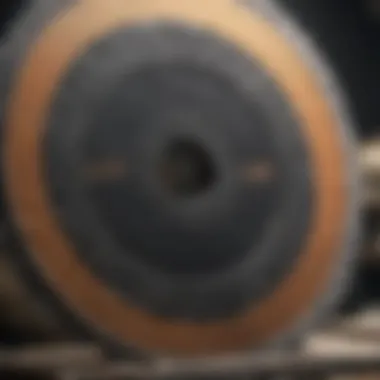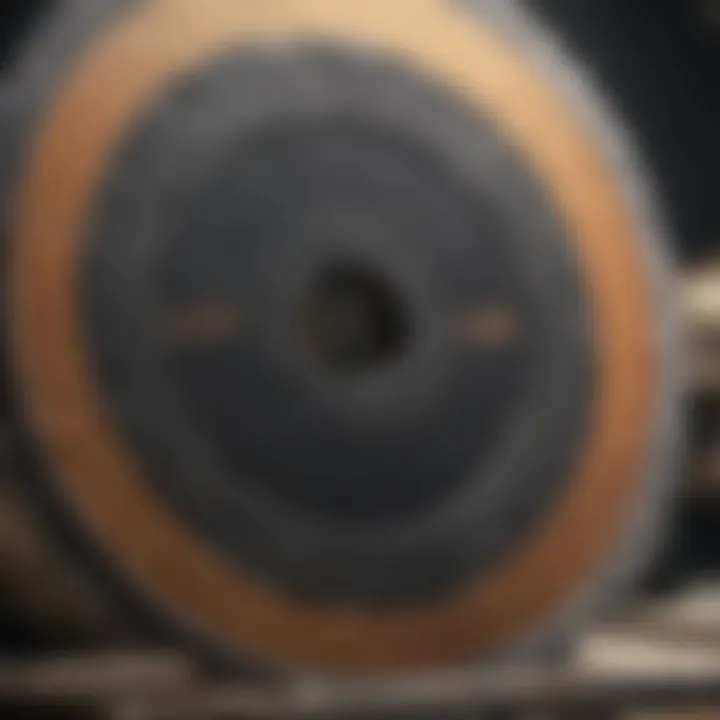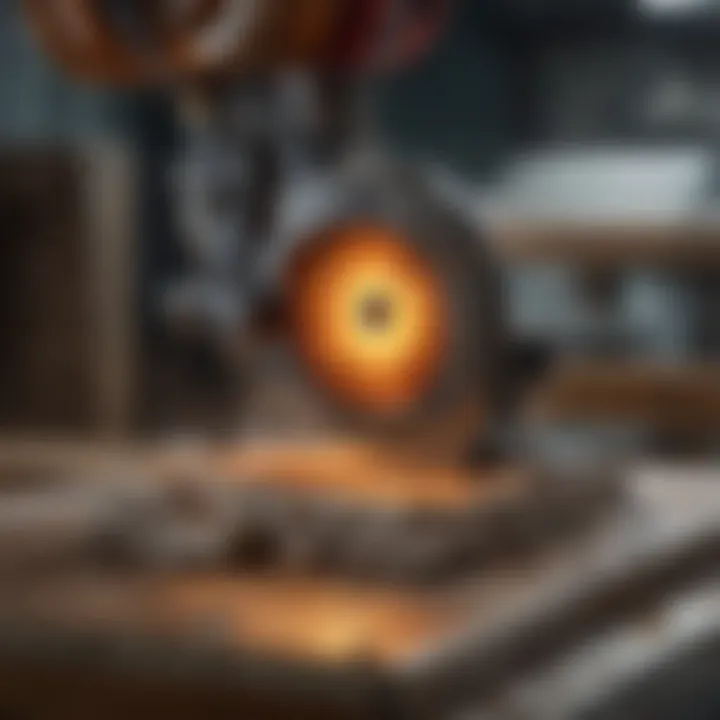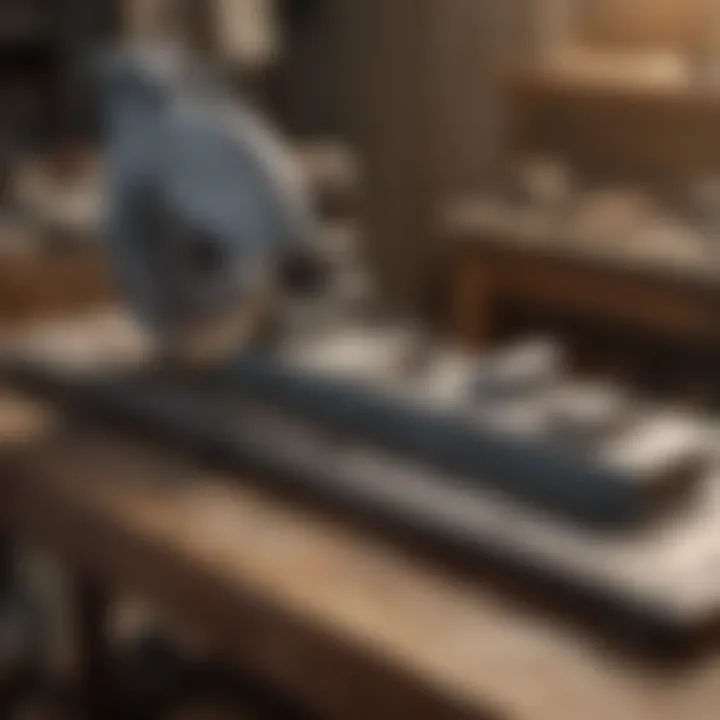Understanding Lapidary Slab Saws for Gemstone Cutting


Intro
Lapidary slab saws are essential tools in the world of gemstone cutting and rock polishing. Their significance cannot be overstated, as they enable both hobbyists and professionals to create intricate designs from raw stones. A deeper understanding of these machines can significantly enhance the quality of one's finished products. This article delves into various aspects of lapidary slab saws, including technical specifications, operational practices, and maintenance requirements.
Featured Collectible of the Month
Overview
This month, we focus on the stunning Blue Lace Agate. Known for its delicate bands of light blue, this stone showcases the effectiveness of lapidary slab saws in cutting and polishing. Collectors often seek this collectible due to its beautiful patterns and gentle hues.
Historical Significance
Blue Lace Agate has a rich history. It originates from South Africa and has been used in jewelry and decorative items for centuries. The gem possesses calming properties, making it a favorite among crystal enthusiasts. Using a lapidary slab saw ensures that the natural beauty of this stone is preserved while enhancing its visual appeal.
Identification Techniques
Identifying the right geological materials for cutting is vital. Lapidary enthusiasts must learn how to distinguish between different rocks and gemstones to ensure quality craftsmanship.
Visual Characteristics
When examining Blue Lace Agate or similar stones, note the following:
- Color Bands: Look for light blue to darker blue bands.
- Translucency: A good quality stone is typically translucent, allowing light to pass through slightly.
- Surface Texture: The surface should be smooth and polished, indicating quality cutting.
Resources for Identification
For further identification, consider using these resources:
- Wikipedia
- Britannica
- Forums like reddit.com for community insights.
"Investing time in learning about materials can elevate your lapidary skills immensely."
Culmination
Understanding lapidary slab saws and their capabilities provides a strong foundation for any collector or enthusiast. As demonstrated in the exploration of Blue Lace Agate, the right tools and knowledge can transform raw materials into stunning works of art.
Prolusion to Lapidary Slab Saws
Lapidary slab saws play a critical role in the field of gemstone processing. These tools are essential for those who want to transform rough stones into polished, beautiful pieces. Understanding slab saws is fundamental for both hobbyists and professionals in the lapidary arts. This section delves into key aspects of slab saws, outlining their definitions, purposes, and the historical evolution that has shaped their development.
Definition and Purpose
Lapidary slab saws are specialized saws designed to cut larger pieces of stone into manageable slabs. Unlike other saws that may target smaller or more intricate cuts, slab saws focus on slicing broader sections of material. This is important, as it allows artisans to create slabs that can later be shaped, polished, or set into jewelry. The ability to cut through various materials, including agate, quartz, and other gemstone types, is a defining characteristic.
The purpose of using a slab saw is not merely to make cuts but to ensure these cuts preserve the integrity of the stone. A skilled user can highlight the natural beauty and patterns within the stone. Thus, the choice of a lapidary slab saw often reflects the user’s artistic intent and the types of materials they wish to work with.
Historical Context
The origins of lapidary saws can be traced back to ancient civilizations. Initially, stone cutting was a labor-intensive process, often performed manually with rudimentary tools. With the advent of industrialization, innovations in technology allowed for the creation of more effective cutting instruments. Early saws were typically powered by water wheels or simple hand-cranks.
The evolution of lapidary slab saws accelerated in the 20th century when electric power became widely available. This transition provided greater precision and efficiency in cutting, significantly influencing the lapidary community. Changes in blade technology, such as the introduction of diamond-impregnated blades, further improved the capability of these saws, allowing lapidaries to work with harder materials with ease. Understanding this history is vital as it informs users not only about how slab saws have changed but also about their current applications and potential innovations in the future.
"Over time, lapidary slab saws have evolved from manual tools to sophisticated machines capable of precise, intricate cuts."
In summary, the introduction to lapidary slab saws is more than a simple overview; it is a gateway to understanding the medium of lapidary arts itself. It sets the foundation for exploring various types of saws, their operational mechanics, and the vital role they play in the craftsmanship of gemstone collectors.
Types of Lapidary Slab Saws
Understanding the various types of lapidary slab saws is essential for anyone serious about gemstone cutting and rock polishing. Choosing the right saw can greatly affect the quality of the finished product and the efficiency of the cutting process. Here, we explore the key differences among sawing systems, cutting blades, and size classifications to offer clarity to potential users.
Vertical vs. Horizontal Saws
Vertical and horizontal lapidary saws are two primary configurations available in the market. Each design presents specific advantages and disadvantages that users should consider based on their needs.
Vertical saws have blades that are positioned vertically, allowing for easier access to the material being cut. This setup is often preferred when making intricate cuts in gemstones or fossils, as it provides better visibility and control. Because of the vertical arrangement, it tends to occupy less horizontal space, which can be beneficial for those with limited workshop areas.
On the other hand, horizontal saws feature blades that are aligned horizontally. These machines are generally more suitable for larger and denser materials. The horizontal setup also allows for longer cuts without needing to reposition the material frequently. Enthusiasts focused on large slab work often favor this type for its efficiency.


Both designs serve their purpose well. The choice between the two should come down to the specific requirements of the project and available workspace.
Blade Types
The selection of blade types is another critical decision affecting the cutting process. Lapidary saw blades come in various configurations, often made from materials such as diamond, carbide, or metal. Diamond blades are particularly well-regarded for their ability to handle hard materials, providing a clean cut with minimal friction and overheating. For softer stones, carbide blades may be a suitable alternative, offering efficient cutting at a lower cost.
Users should also consider the thickness of the blade. Thinner blades typically allow for more detailed cuts but may wear out faster. Thick blades are more durable and can handle extensive use, but they may leave a rougher finish on finer details. The temperature and type of material being cut will help dictate the best blade choice for a given application.
Size Classifications
The size of the slab saw is another factor to consider, as it influences both the size of material you can cut and the availability of workspace. Lapidary saws come in various sizes, typically classified as small, medium, or large.
- Small saws (usually around 6-10 inches) are compact and ideal for beginners or hobbyists. They are manageable but might limit the size of the stones that can be processed.
- Medium saws (approximately 10-14 inches) strike a balance between portability and cutting capability. They are suitable for the moderate collector who wants flexibility.
- Large saws (15 inches and above) cater to professionals or serious hobbyists, allowing for larger slabs of material to be cut, enhancing productivity. However, these saws require significant workspace and a proper setup to manage the weight and dimensions.
When selecting a saw, it is important to evaluate the size of the materials to be worked on and how the saw will fit into your workspace. Assessing personal and project-specific needs will guarantee a more rewarding lapidary experience.
Operational Mechanics
Understanding operational mechanics is essential in optimizing the use of lapidary slab saws. These saws operate on fundamental principles that allow for precise cuts in various materials, ensuring that collectors can achieve desired shapes and finishes. Knowledge of these mechanics can lead to improved results and efficiency in gemstone cutting and fossil preparation.
Basic Components
Lapidary slab saws consist of several core components that work in unison to facilitate cutting. The main parts include:
- Motor: Powers the blade, critical for efficient cutting.
- Blade: Comes in different types and sizes, designed for specific materials. Common blade types include diamond blades, which are preferred for their durability and cutting efficiency.
- Cutting Table: Where the material is placed, and its movement can often be adjusted for precision cuts.
- Water Reservoir: Provides cooling and lubrication to the blade, minimizing wear and preventing overheating during operation.
These components highlight the engineering that goes into slab saws, which allows for effective use in lapidary work. Understanding each part's function can help users troubleshoot and maintain their equipment better.
Cutting Techniques
Effective cutting techniques are instrumental in achieving optimal outcomes with lapidary slab saws. Here are some approaches that practitioners often utilize:
- Feed Rate: Adjusting how quickly the material is fed into the blade affects the quality of the cut. A slower feed rate usually results in a smoother cut, while a faster rate can lead to rough edges.
- Cut Depth: Determining the appropriate depth of cut ensures that the slab is sliced accurately without forcing the blade too much, which could cause damage.
- Angle of Approach: Positioning the material at an angle can enhance cutting efficiency, particularly with tougher rocks.
Mastery of these techniques can distinguish between a successful or a frustrating cutting experience. Collectors often find that experimenting with different methods yields insights into their work habits.
Efficiency Considerations
Efficiency in using slab saws is a blend of proper technique and regular maintenance. Key factors affecting efficiency include:
- Blade Quality: Higher quality blades tend to last longer and require fewer adjustments, which translates to less downtime.
- Material Type: Understanding the characteristics of the materials being cut can inform better practices. Softer stones generally require less power, whereas harder materials may necessitate slower, deliberate cuts.
- Routine Maintenance: Regular checks on the motor and lubrication systems can lead to longer operational life and improved cutting performance.
Efficient use of lapidary slab saws ultimately reflects a user’s knowledge and understanding of operational mechanics, translating into better outcomes for their projects.
"Maintenance and proper handling not only prolong the life of your equipment but also enhance the quality of your finished products."
Selecting the Right Slab Saw
Selecting the right slab saw is pivotal for anyone serious about lapidary work. The decision impacts both the quality of cuts and the overall efficiency of the processes involved in gemstone cutting and fossil preparation. A well-chosen saw ensures clean, precise slices, allowing for better shaping of the material. Incorrect choices can lead to wasted materials and increased frustration, which can dissuade even the most passionate hobbyists or collectors.
Material Compatibility
One of the first considerations when choosing a slab saw is the compatibility with various materials. Different gemstones and fossils have distinct physical properties, meaning they react differently to saws. For instance, softer stones like soapstone can be cut with a less robust saw, while harder materials such as quartz or agate require saws with specialized blades designed for strength and durability.
- Types of Materials: Think about the types of rocks or fossils you commonly work with. Some common materials include:
- Blade Selection: Compatible blades can enhance or hinder performance. Diamond blades are often preferred for harder materials, while carbide blades work well for softer stones. Knowing your materials helps assure that you buy a saw that complements your work.
- Agate
- Jasper
- Fossils
- Opal
- Diamonds
Budget Considerations
Establishing a budget is essential when selecting a slab saw. Pricing can vary significantly based on brand, features, and capabilities. Expensive saws might come with advanced functionalities, yet may not be necessary for a beginner or occasional user.
- Initial Investment: Consider not just the cost of the saw, but also ongoing expenses, like replacement blades and maintenance.
- ROI on Quality: Sometimes, paying more for a quality saw can yield better long-term results in terms of durability and performance. Opting for cheaper, lower-quality models might seem enticing but can lead to greater costs over time due to repairs or replacement needs.
User Experience Levels
Your skill level plays a crucial role in determining the right slab saw. Beginners might benefit from simpler models that are easier to operate, while seasoned users may find advanced options more beneficial.


- Beginners: Look for user-friendly saws with clear instructions. Initial setups should be straightforward, minimizing potential errors.
- Intermediate Users: As skills develop, a more robust saw may be appropriate. This can include models with adjustable features for different cutting styles.
- Advanced Users: Experienced lapidarians may prefer sophisticated saws with advanced technology that supports detailed and precise work, enabling customizations to suit their preferences.
Maintenance and Care
Maintaining lapidary slab saws is crucial for optimal performance and longevity. Regular upkeep ensures that these machines operate efficiently, reducing the risk of damage and increasing precision in cuts. When slab saws are well-maintained, they can provide consistent results over years of use, which is essential for both hobbyists and professionals.
Routine Maintenance Practices
Routine maintenance practices form the backbone of effective care for slab saws. Here are some essential activities to consider:
- Cleaning: Keeping the saw free of dust and debris is vital. Use a soft cloth to wipe down the surface and remove any cutting residue. This prevents tools from seizing up and ensures smooth operation.
- Lubrication: Regularly applying a suitable lubricant to components, such as the blade spindle, helps ensure that moving parts operate without friction. Check the manufacturer's guidelines for appropriate lubricants.
- Blade Inspection: Periodically inspect the saw blades for wear and tear. If you notice dullness or chips, it may be time to sharpen or replace the blade. This ensures that cuts remain clean and precise.
- Alignment Checks: Ensure that the blade is properly aligned. Misalignment can lead to uneven cuts or a damaged device. Use a level to check alignment and make adjustments as needed.
- Electrical Connections: Inspect electrical connections and cords regularly to avoid potential hazards. Replace any damaged wires immediately to maintain safety while working with the saw.
Implementing these routine practices can help prevent costly repairs and prolong the service life of the slab saw.
Common Issues and Solutions
Despite regular maintenance, users may encounter certain common issues with slab saws. Here are some of these problems and their corresponding solutions:
- Blade Bind: If the blade binds during cutting, it can create a dangerous situation. To resolve this, ensure that the material being cut is adequately supported, and reduce the cutting speed if necessary.
- Overheating: Overheating may occur due to excessive friction. This can be fixed by increasing the coolant flow or adjusting the feed rate. Continuous monitoring during operation is essential.
- Uneven Cuts: If the cuts are not consistent, check for blade wear or misalignment. If the blade is worn, replacing it should resolve the issue. Realigning the blade may also restore precision.
- Noise Issues: Unusual noises can indicate a mechanical problem. Investigate by checking for loose components or inadequate lubrication. Tightening bolts and applying lubricant can often rectify the issue.
- Electrical Failure: If the saw does not power on, check the fuse and ensure that the power supply is operational. Replacing a blown fuse or ensuring proper connections might restore functionality.
By understanding these common issues and their solutions, users can manage their slab saws more effectively, leading to enhanced performance and satisfaction.
"Routine maintenance is not just a chore; it is an investment in the longevity and reliability of your tools. Every moment spent on upkeep translates to years of improved performance and fewer headaches."
Integrating these practices and solutions into your maintenance routine is essential for anyone serious about lapidary work, reinforcing the investment made in high-quality lapidary slab saws.
Safety Protocols of Using Slab Saws
Safety protocols are a crucial aspect of using lapidary slab saws. These saws, while powerful and efficient tools for cutting stone, pose inherent risks that must be recognized and mitigated. The act of cutting hard materials can generate flying debris, noise, and vibration, all of which can harm the user if proper precautions are not taken. Ensuring a safe working environment not only protects the individual but also enhances the overall cutting process.
Applying the appropriate safety measures can profoundly reduce the likelihood of accidents. Consistent adherence to safety guidelines instills a sense of responsibility amongst users and helps them recognize the importance of protecting themselves.
Personal Protective Equipment
Using personal protective equipment (PPE) is fundamental when operating slab saws. The right gear significantly reduces exposure to hazards. Essential PPE include:
- Safety Glasses: Shields the eyes against flying fragments or dust. Regular glasses do not offer sufficient protection.
- Hearing Protection: Prolonged exposure to noise can lead to hearing loss. Earplugs or earmuffs should be worn during operation.
- Dust Masks or Respirators: Cutting stones generates fine dust, which can be harmful when inhaled. A mask is essential for filtering these particles.
- Gloves: Protect the hands from sharp edges, particularly when handling rough stones or making adjustments on the saw.
- Protective Footwear: Steel-toed boots offer protection from heavy stones that might fall.
Using these items is a small investment compared to the potential costs of injuries or health issues.
Operational Safety Guidelines
In addition to wearing appropriate PPE, following operational safety guidelines is vital for risk management when working with slab saws. Consider the following best practices:
- Inspect Equipment: Regular checks on the saw and its blade for wear and tear can prevent mechanical failures, which can lead to accidents.
- Secure Work Area: Ensure the working space is clean and organized. Remove any unnecessary objects to avoid tripping hazards.
- Proper Training: Users should be trained in the operation and maintenance of slab saws. Knowledge of the equipment reduces misuse.
- Follow Manufacturer Instructions: Each saw model comes with its own specifications. Familiarize yourself with the user manual for optimal and safe operation.
- Use a Water Supply: When cutting, a continuous water supply cools the blade and reduces dust. This is doubly beneficial—it enhances cutting performance and reduces airborne particles.
Always remember, safety is not just about wearing gear; it's about establishing a culture of caution and awareness.
By observing these safety protocols, both novice and seasoned lapidary enthusiasts can significantly mitigate risks associated with slab saw operation. A commitment to safety not only safeguards the user, it enhances the overall experience of the craft.
Innovations in Lapidary Technology
The field of lapidary work has seen numerous advancements in technology, which have greatly enhanced the precision and efficiency of cutting and polishing gemstones. These innovations are crucial for both professional gemologists and hobbyist collectors alike. Understanding the specific innovations can lead to better decisions when selecting tools and methods for lapidary projects.
Advancements in Blade Materials
Recent developments in blade materials have significantly improved the performance of lapidary slab saws. Traditionally, blades were made from general steel or diamond. Now, advanced materials such as polycrystalline diamond (PCD) and cubic boron nitride (CBN) offer enhanced durability and longevity.
Using blades made from these materials allows for smoother cuts and prolonged usage before the need for replacement. The ability to maintain sharpness also means less time spent changing out blades and more focus on the actual cutting process.
Here are some points to consider regarding modern blade technologies:
- Durability: New materials resist wear and tear, thus lasting longer than their predecessors.
- Cutting Efficiency: Improved cutting technology reduces the time required to achieve desired results.
- Compatibility: Advances in blade design now allow for use with a wider variety of rocks and gemstones, broadening the scope of what can be worked on effectively.
In summary, selecting blades made from modern materials offers substantial performance boosts for lapidary enthusiasts.
Automation in Slab Saws


The integration of automation in lapidary slab saws marks a notable shift towards improved efficiency in the workspace. Automated slab saws can now execute precise cuts with minimal manual intervention. This is particularly advantageous for those who are not as experienced in the craft.
Automation can take various forms, including:
- Programmable Settings: Operators can input specific cutting parameters, enabling the saw to perform designated cuts without constant supervision.
- Speed Regulation: Automated systems can optimize cutting speeds based on material type. This ensures that softer gems are not damaged and harder materials do not wear down the blade too rapidly.
- Consistent Quality: Automation helps in achieving consistent results across multiple cuts, which is critical for those looking to create a series of identical pieces.
The benefits of utilizing automation extend not only to efficiency and convenience but also to the quality of the work produced. As technology evolves, the traditional and labor-intensive methods of gem cutting are being replaced with more sophisticated solutions, paving the way for higher standards in both craftsmanship and productivity.
In the realm of lapidary work, understanding innovations in technology is essential for anyone serious about their craft. Investing in modern tools not only improves productivity but also the quality of the final product.
Applications of Lapidary Slab Saws
Lapidary slab saws play a critical role in various applications, which go beyond mere hobbyist use. Their precision, efficiency, and unique capabilities make them invaluable tools in both gemstone cutting and fossil preparation. Understanding the intricate applications of these saws enriches not only one’s mining experience but also one's appreciation for the art of gemology overall.
Gemstone Cutting
Gemstone cutting is one of the primary applications of lapidary slab saws. The process involves transforming rough stones into beautifully polished gemstones ready for jewelry or display. Slab saws allow for accurate cuts, ensuring minimal waste of precious materials. Beyond aesthetics, the quality of the cut greatly influences the stone’s value and brilliance.
When cutting gemstones, factors such as the hardness of the material and the desired shape must be considered.
- Soft stones, like opal, require gentler techniques to prevent chipping.
- Harder materials, such as sapphire or diamond, allow for more aggressive cutting but demand high-quality blades to maintain precision.
The benefits of using slab saws in gemstone cutting include:
- Consistency: Producing evenly shaped slabs enables easier crafting of finished pieces.
- Versatility: They can cut various types of material from common quartz to exotic stones like jade or lapis lazuli.
- Customization: Artists can create custom cuts that enhance the unique characteristics of each gemstone, adding personal significance.
Fossil Preparation
Apart from gemology, slab saws are significantly utilized in the field of fossil preparation. Fossils are often embedded in rock matrices, making them challenging to extract without damaging the specimen. A slab saw provides the precision necessary to reveal fossilized remains while minimizing damage.
In fossil preparation, the applications are as follows:
- Layer Removal: The saw can slice away layers of rock that encase fossils, allowing for a clearer view of the specimen without excessive manual chiseling.
- Thin Sections: Researchers and collectors can create thin slices of fossils for microscopic examination. This is vital for paleontological studies that require detailed analysis.
- Preservation: A well-executed cut allows for better preservation of the specimen. Poor cutting techniques can lead to cracks or fractures, compromising its integrity.
Using a lapidary slab saw for fossil preparation increases the chance of recovering intact specimens significantly.
The applications of lapidary slab saws in these areas underscore their importance in the lapidary arts. Whether working on stunning gemstones or preserving ancient fossils, the precision and versatility of slab saws are crucial for collectors and professionals alike.
The Role of Slab Saws in Collecting
Lapidary slab saws play a crucial role in the world of collecting, particularly for enthusiasts focused on gemstones and fossils. The precision and control offered by these saws enhance the collector’s ability to create and refine pieces that reflect individual style and quality. Through careful cutting, collectors can transform raw materials into stunning specimens. This process not only allows for personal expression but also ensures that the pieces obtained are unique.
Custom Cuts and Personal Style
Custom cuts are essential for any serious collector. Each lapidary artist brings their own flair to the cutting process, and unique cuts can elevate a stone's natural beauty. A collector who uses a slab saw can make adjustments to sizes and shapes that traditional cutting methods might restrict. This capability allows for personalized designs that resonate with the collector's vision, whether it's a simple cabochon or an intricate artistic piece. Custom cuts can turn ordinary rocks into one-of-a-kind treasures.
Moreover, personal style influences how collectors approach their choices. Some prefer geometric shapes, while others may lean towards organic forms. The versatility of lapidary slab saws means that both styles can be achieved. By experimenting with various cuts, collectors differentiate their collections from the mainstream, which can be very satisfying. The act of personally shaping each piece is often as rewarding as the final product provides, nurturing a deep connection between the artist and their work.
Market Demand for Unique Pieces
As the collecting community evolves, so does the market demand for unique pieces. With an increasing awareness of the artistry involved in lapidary work, collectors are searching for items that stand out. An essential factor that influences demand is the rarity of specific cuts or styles. Collectors prioritize distinctive features that convey both quality and attention to detail.
Furthermore, limited edition cuts or those created using unconventional techniques can attract premium prices. As collectors aim to build unique collections, their choices may lead them to specific niche markets. A slab saw, when used effectively, becomes a powerful tool in meeting these market needs. The ability to customize cuts significantly enhances the value of a piece, making it more appealing to potential buyers.
In summary, the relationship between lapidary slab saws and the collecting world is multifaceted. Whether creating custom cuts that reflect personal style or responding to market demand for unique pieces, these saws empower collectors to explore and refine their craft further. The art of lapidary becomes not just a means of expression but also a business opportunity for many, revealing the profound impact slab saws have on this dynamic field.
Epilogue and Future Directions
The conclusion of this article serves as an important reflection on the relevance and application of lapidary slab saws within the realm of gemology and rock collecting. As explored, these tools not only facilitate the transformation of raw stones into stunning pieces of art but also embody a critical intersection of technology and craftsmanship. The significance of employing the right slab saw is evident, as it influences not just the quality of cuts but also the safety and efficiency of the entire lapidary process. Therefore, as we move forward, understanding these elements becomes crucial for enthusiasts and professionals alike.
Summary of Key Insights
Throughout the article, several core insights have emerged regarding lapidary slab saws:
- Functional Diversity: Different types of slab saws serve various purposes, from vertical to horizontal designs, catering to diverse needs in the cutting process.
- Efficiency and Maintenance: Proper maintenance practices can prolong the life of saws, minimizing the impact of wear and tear on performance.
- Safety Protocols: Adhering to robust safety measures is paramount to prevent accidents during operations, particularly given the use of powerful machinery and sharp blades.
- User Experience: Personalizing the slab saw choice based on user experience level and material compatibility ensures optimal results.
Potential Areas for Further Research
As technology advances, there are multiple areas for further exploration within the field of lapidary. Notably, research opportunities include:
- Innovative Materials: Investigating new blade materials that offer enhanced durability and cutting precision could significantly elevate the craft of lapidary.
- Automation Processes: The implementation of automation in lapidary operations can lead to increased efficiency and reduced mistakies, making the process more accessible to hobbyists.
- Sustainability Practices: Developing eco-friendly practices within lapidary could attract environmentally conscious collectors and foster a community dedicated to sustainable gemology.
- Educational Resources: Creating specialized training programs or workshops can further bridge the knowledge gap for new collectors and enthusiasts, providing hands-on experience with advanced slab saw techniques.
Adapting to these emerging trends will define the future landscape of lapidary work and its role in both creative and commercial avenues.
Overall, the exploration of lapidary slab saws highlights not only a technical understanding but also the art behind the process, merging the old traditions with new technologies to captivate the future audience of rock and fossil collectors.



